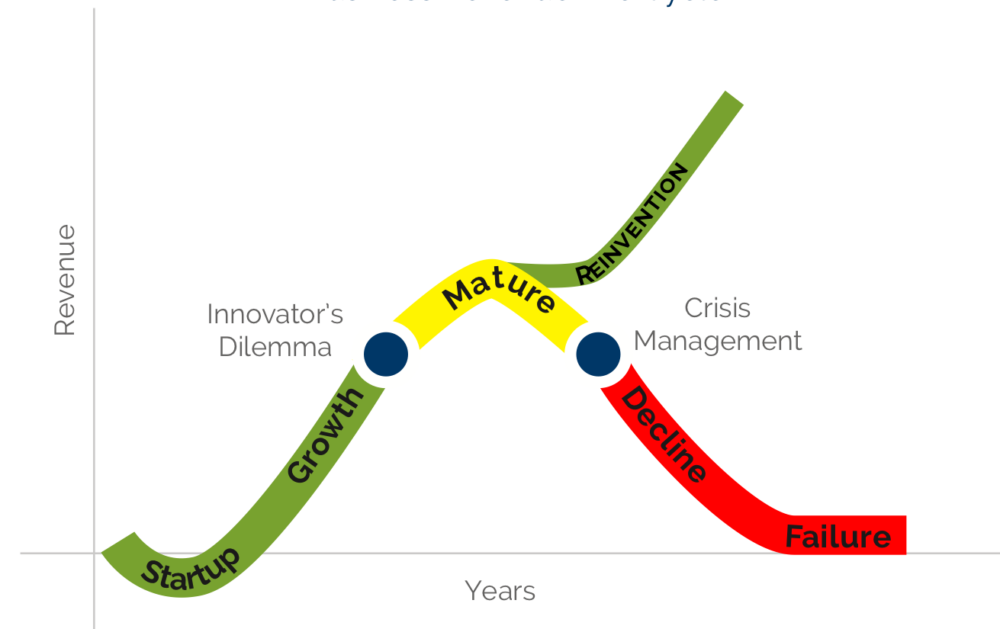The life cycle of consumer products is on constant repeat. Once it starts growing and gaining a large customer base, it risks disruption from another new and innovative product. These usurpers then grow and themselves are eventually displaced. This is the disruption pattern that Clayton Christensen calls “the Innovator’s Dilemma”, and it happens at a faster pace in technology products.

Here is the thing about products with large audiences: By the time you get there, your user base becomes part of the last generation. You will start seeing competition from startups who are targeting the new generation and growing their audience faster than you were at their age!
To stave off the Innovator Dilemma, incumbents need to organize and not interfere with smaller and more agile subsidiaries whose goals are to disrupt their large parents by attacking underserved markets, exploiting immature technologies, or building products that cannibalize the parent products.
Why Companies Struggle With Innovation
Large companies’ dynamics can create unwanted headwinds to these subsidiaries or teams through extending their management power grip, throttling their finance, assigning resources they would rather keep away… etc. Executive management at such organizations should be aware of that and facilitate a healthy environment for these innovative groups to grow and do their best to disrupt their parents.
Although the Innovator’s Dilemma is known to executives and not a secret, consumer product companies still get disrupted all the time because of the powerful inertia that occurs from their success. Such companies usually hold the following beliefs:
- They can get their customer base to move easily to the new product they create
- They can change the intent of their customers to fit their new product
- Most of the time they keep following the same business model and they think they can still monetize new products with the same model
While these beliefs look fine at the surface, it is often a deadly mistake to try and change the intent of your existing customer. Most customers use a product because they have a specific intent and that doesn’t necessarily hold true for your new product. You should be looking for a new market/personas, problem scenarios, and business model rather than trying to protect your existing customer base.
Solutions
As companies grow, they tend to move from innovation to scaling mentality and recruit people who are more specialized to end up working in silos and each team grows its area such as product, finance, HR, and marketing in a way to serve the current product line and existing customers.
Some of them try unique ways to keep the innovation pace, and oftentimes they resort to the following solutions whether through acquisitions or creating subsidiaries/teams as I mentioned earlier.
Family of Brands
It’s hard to innovate on a single and popular product. So, successful consumer companies often end up with new ones in addition to their flagship. This transformation from a single product to a family of products occurs when a consumer business reaches a saturation point for its market.
Facebook is the best example with their 2.7 billion monthly active users! The different products they built or acquired are still running under different brands like Instagram, WhatsApp, and Messenger. They didn’t integrate them and kept them running separately with their teams.
I mentioned Facebook because it is a technology company but P&G is the first company to use this strategy and has helped it survive and grow for more than 180 years!.

Disrupt Your Own Products
Apple is a good example, their strategy is to cannibalize their products by creating new products that fulfill some of the same consumer needs as the existing ones. They also move towards an ecosystem of Apple products but they always make sure their products work exceptionally well together.

Amazon has cannibalized its physical book sales and invented Kindle that has become the world’s biggest bookstore! If Amazon didn’t do it, someone else would have! They provided a cheaper and more accessible way to read books, sold around 90 million Kindle and half a billion Kindle books by 2017!

Amazon is also big on the Familia’s of Brands approach and has several independent brands like Zappos.com, Diapers.com, audible.com, IMDb.com Woot.com, Fabric.com, Soap.com, Pets.com, and many more.
Conclusion
A company that has grown in size and achieved success in one or more products should continue to disrupt itself and create new products that cannibalize their own. They just need to factor this cannibalization in the product’s business model. Having your products competing with each other is way better than having an external company that leverages the latest technological innovation to come up with competing (often more accessible or cheaper, or both) products and take a bite from or all your customer base.